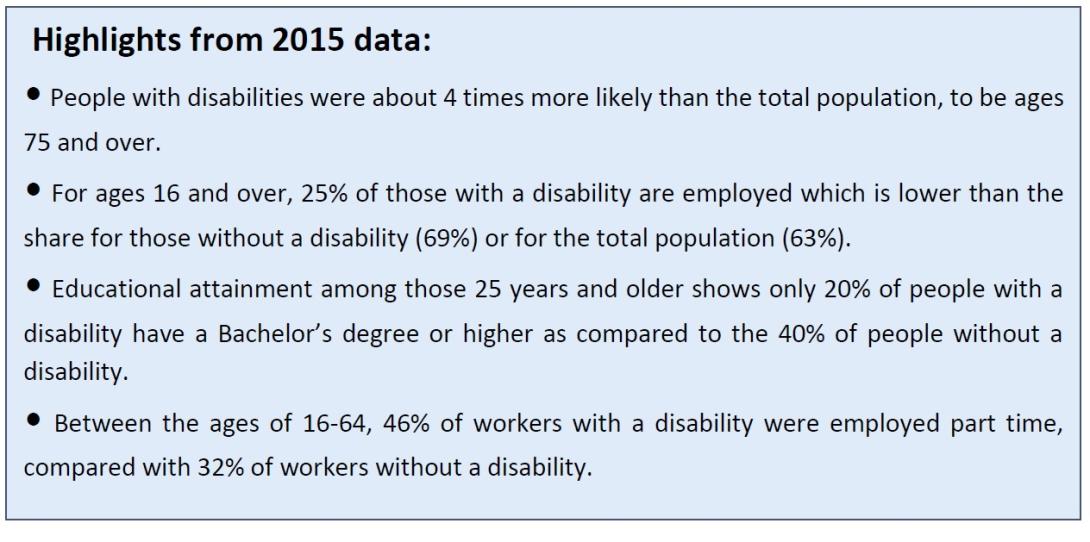Disability dynamics in Virginia

Last month, in observance of National Disability Employment Awareness Month, the U.S. Bureau of Labor Statistics released data reflecting the work contributions of Americans with disabilities and the employment difficulties they may face. This year’s theme “#InclusionWorks” seeks to generate further awareness of workers with disabilities by embracing individual differences and fostering workforce diversity. Nearly 5.2 million people with disabilities were employed across the country in 2015, largely concentrated in management, professional, and related occupations (31.3%). This made me curious about the labor force characteristics of Virginians with disabilities.

In 20151, 11.5% of Virginians (935,187 people) reported a disability. The six disability types covered here are:
- Hearing difficulty — deaf or having serious difficulty hearing
- Vision difficulty — blind or having serious difficulty seeing, even when wearing glasses
- Cognitive difficulty — Because of a physical, mental, or emotional problem, having difficulty remembering, concentrating, or making decisions
- Ambulatory difficulty — Having serious difficulty walking or climbing stairs
- Self-care difficulty — Having difficulty bathing or dressing
- Independent living difficulty — Because of a physical, mental, or emotional problem, having difficulty doing errands alone, such as visiting a doctor’s office or shopping.
Respondents who reported having any one of the six disability types are considered to have a disability, but because some may report more than one, the numbers do not add up to the total.
The age distribution of those reporting a disability shows that aging is a crucial factor. While those age 65 or older only account for 14% of the total population, they are more than 40% of the people who reported a disability.

Education is one of the main precursors of employment, and attainment is skewed across Virginians aged 25 and over, grouped by their disability status. 23% of people with a disability have less than a high school degree (many more than the 9% for those without a disability). On the other end of the academic spectrum, only 19% of those with a disability have a Bachelor’s degree or higher, which is much lower than the 40% of individuals without a disability.

Nearly 900,000 people with disabilities are employed across the Commonwealth. Employed people with disabilities are more likely to either be self-employed, or work for non-profits or governmental (state or federal) organizations. The largest employment share among people with disabilities are within the management, business, science, and arts occupations.

Among those with a disability who worked year round, 115,096 people worked full time, while 98,254 were part-time workers. The employment share for Virginians with a disability is at 25%, which is lower than the statewide 63%, for the population of age 16 or over. BLS suggests this could partially be due to the age profile, as older individuals are less likely to be working, irrespective of their disability status. In a follow-up post, I will try to look at how disability affects a person’s labor market behavior (job opportunities and productivity) and examine the lifetime losses in earning capacity as a result of disability.
________________________________________
Footnote 1: All data is from the 2015 American Community Survey 1-Year Estimates.



